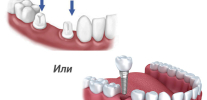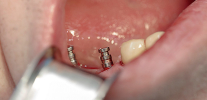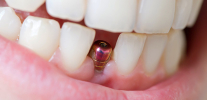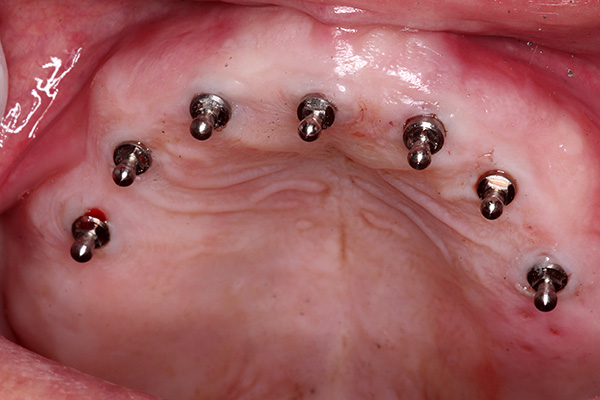
Next you will learn
- When the use of mini-implants is more preferable than traditional methods of prosthetics;
- How mini implants are selected and installed;
- The cost of prosthetics using mini implants from different manufacturers;
- Disadvantages of using this prosthetics technology.
Mini-implants are, in fact, a smaller version of standard implants used to fix dentures and (less commonly) small fixed bridges.
It is important to understand that mini implants are not an alternative to standard implants. Let's see what this technology is like, how prostheses are installed on mini-implants and how convenient and durable such prosthetics are.
Technology of fixation of prostheses on mini-implants and the scope of its application
Externally, mini-implants are somewhat similar to classical implants, but have a significantly smaller diameter. The standard diameter of the thread in them is 1.8-2.4 mm, due to which their introduction into the bone is less traumatic, and the installation as a whole is much faster - this is similar to screwing a self-tapping screw into the bone (the lower part with the thread is screwed into the bone, and then the prosthesis is attached to the upper one). Depending on the type and shape of the abutment, all designs differ both in the field of their application and in durability, versatility and, therefore, price.
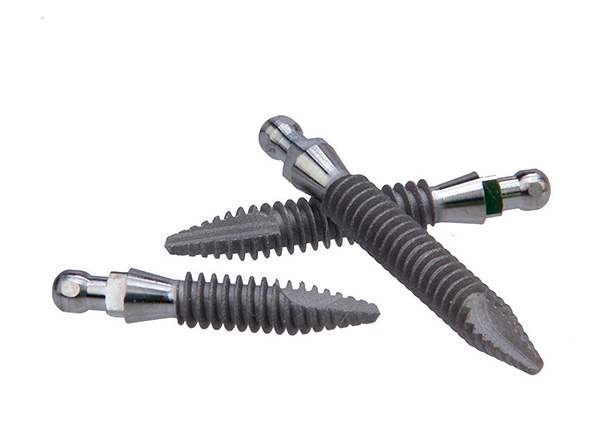
As noted above, mini-implants are most often used to attach removable dentures. Depending on the size of the prosthesis itself, a different number of implants can be installed in the jaw, on which a single prosthesis is then attached. This provides a rigid fixation of the prosthesis itself, its immobility when eating and talking, and, most importantly, the general wearing comfort. At the same time, the prosthesis itself can be removed and installed on the implants many times, and when using some types of abutments, an unlimited number of times.
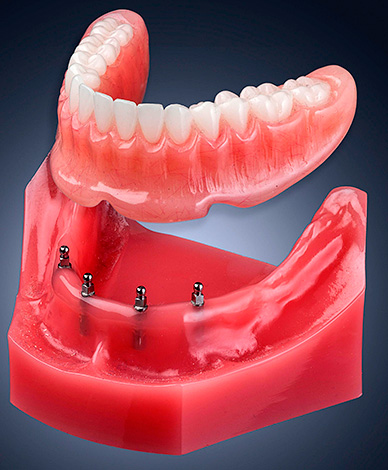
On a note
It is also possible to install fixed bridges on mini-implants. This design is much less reliable than it, fixed on classical implants, but in some cases it has no alternatives. For example, if the alveolar process of the lower jaw is very thin for standard implants, and the patient cannot perform bone grafting to expand the bone for one reason or another.
In some cases, mini-implants are used in orthodontics as levers rigidly fixed in the bone for further correction of the position of the teeth. However, such an application of them happens even less frequently than the installation of fixed bridges.
The main advantages of technology
One of the main advantages of mini-implants is the low invasiveness of the operation to install them. Moreover, during implantation, both the bone in which the implants are fixed and the gum, which must be excised for this, are less damaged.
Consequently, all tissues heal faster after surgery, and cases of rejection of mini-implants are more rare than cases of rejection of classic dental implants.
Due to the high healing speed, the operation of installing mini-implants is carried out faster, and in some cases it is possible to implant and install ready-made prostheses on implants in one procedure.
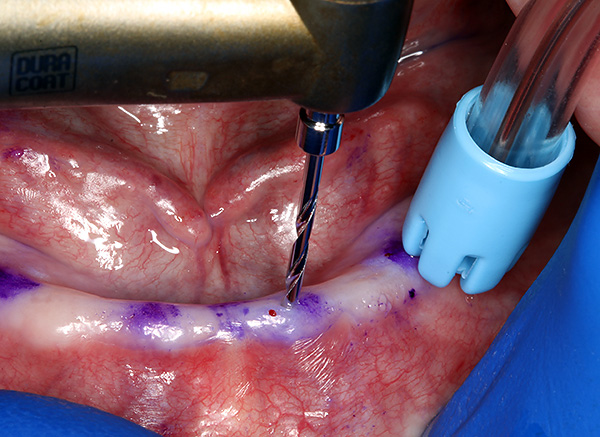
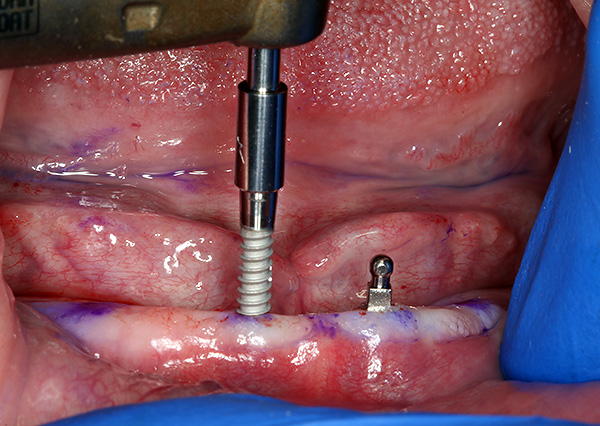
At the same time, the prosthesis itself is very securely fixed on implants - this is another important advantage of this version of prosthetics. Due to the rigid fixation, it becomes possible to reduce the size of the plastic base of the prosthesis, making it less bulky and almost invisible to the patient (there will be no gag reflex, changes in diction, and a decrease in taste sensations).
Also mini-implants allow avoiding bone grafting - an expensive, complex and quite large-scale operation.
Therefore, in the case when it is not possible to install classical implants and removable prosthetics is inevitable, mini-implants make it possible to use removable prostheses more comfortable for the patient and at the same time almost invisible to others.
In addition, the installation of mini implants costs much less than classical implantation. For many patients, this is a decisive factor, and often it is at the expense of lower cost that people choose removable prosthetics on mini implants.
Types of mini-implants and rules for choosing between them
Mini-implants are classified according to several parameters, but the most important of them is the type of abutment - that part of the implant that protrudes above the mucous membrane and onto which the prosthesis or crown is then attached.
Abutment can be fixed and removable. In the first case, the entire implant is a single, non-separable structure, in the second it is a prefabricated unit in which the threaded element takes root in the bone over time, and the abutment can be replaced as it wears. Moreover, such a replacement will not require excision of the gums and twisting of the part with a thread from the bone.
As a rule, removable dentures use fastenings for spherical abutments. Due to the constant friction between the attachment socket in the prosthesis and the abutment itself under load when chewing, the surface of the abutment wears out on average for 2-3 years. In this case, at first some mobility of the prosthesis appears, which eventually begins to interfere with the person, and then the prosthesis can even begin to jump off the implants.
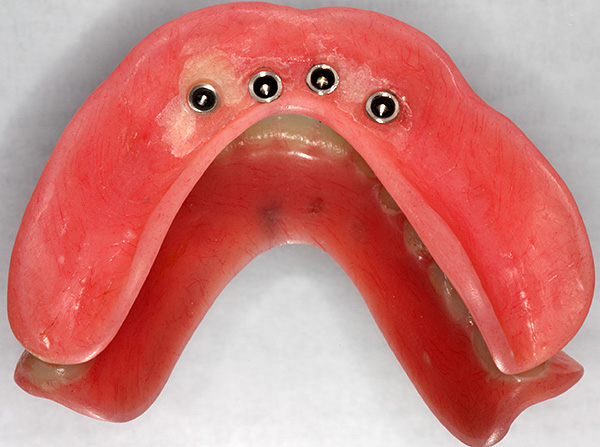
On a note
Non-removable abutments from some manufacturers are covered with titanium nitride on top, which to some extent slows down their wear and increases their service life. However, this decision is also temporary - such abutments are also erased, and as a result, the implants have to be changed with them.
Given that the replacement of the implant in its complexity (and cost) is similar to installing a new one, nobody would like to carry out such a procedure once again. In addition, due to age-related thinning of the bone, the patient may not be able to replace the implant at all over time, or the new one will not be fixed reliably.
Therefore, it is usually recommended to choose mini implants with removable abutments. They are more expensive, but they guarantee that it is no longer necessary to remove the threaded part from the bone.
Removable abutments, in turn, can be of two types:
- Traditional spherical - less durable and requiring more frequent replacements. In the prosthesis for such abutments, spherical nests are made in which there are metal latches with a silicone seal. When the prosthesis is put on implants, the spherical abutment enters the silicone matrix and is fixed in it. Planted on several implants, the prosthesis is rigidly fixed to them;
- Equatorial Abutments with Locator Technology®, eliminating the problem of wear - such abutments do not have to be changed at all. They have a flat horizontal top surface and rounded edges, and the silicone seal can be worn even at an angle. This allows you to safely put the prosthesis even on implants whose axes are not parallel and are located at an angle of up to 40 ° to each other. Dentures on such implants, although they require servicing by a dentist, have to be performed less frequently than servicing dentures on spherical implants.
Mini-implants vary in cost, and the patient can choose the option that will be optimal for him by the combination of price-convenience.
Manufacturers and the most famous brands of mini implants
The choice of mini-implant manufacturers is less wide than that of classic implant manufacturers, since not every brand has a line of such products.Also, different brands specialize in implants with removable and fixed heads.
As of 2019, the following brands are most widely used in dental clinics in Moscow:
- Osstem (South Korea);
- Roott (Switzerland);
- Alpha BIO (Israel);
- Straumann (Switzerland).
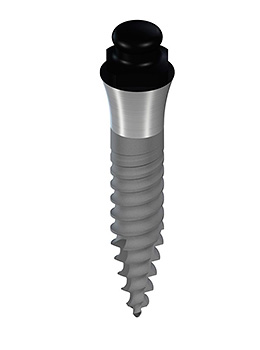
Straumann mini implant (2.4 mm)
Statistically, clinics give a certain priority to Osstem and Roott products, with implants from the first manufacturer more often used for removable prosthetics, and Roott products for the installation of fixed bridges.
Let's now take a closer look at the implants of all four brands.
Osstem Korean mini implants are available with non-removable abutments in the MS line - they are ideal for installation in narrow parts of the jaw to firmly fix the removable denture. There are three types of products in this line:
- Implants for fixation on a narrow bone, usually in the area of the lower incisors;
- Implants designed specifically for fixing removable dentures;
- Implants for the installation of temporary prostheses.
According to the combination of price and quality, Osstem mini-implants are considered optimal today, which corresponds to the manufacturer’s pricing policy (“premium products at the price of economy-class systems”).
Alpha BIO products are widely used in mid-priced clinics due to their relatively low prices and proven reliability. The company produces two types of mini implants:
- ARRP with fixed abutments. They are often used for operations with immediate prosthetics, usually in the region of lateral upper incisors and all incisors in the lower jaw, where the alveolar ridge is quite narrow;
- ARRC with removable spherical abutments. Most often, these mini-implants are used to install removable dentures.
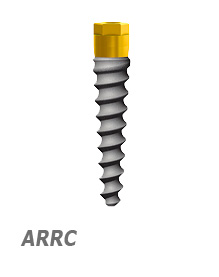
Alpha BIO Mini Implant
Swiss Straumann are considered the most expensive today, and their price corresponds to high quality. According to the statistics of implantologists, Straumann serve on average longer than analogues of other manufacturers, regardless of the type of prosthesis.
Actually, Straumann does not have a separate line of mini-implants, but the thinnest implants of the manufacturer with a diameter of 3.3 mm are used specifically for fixing removable dentures. Moreover, these implants are made without an abutment and are usually combined with the Locator fixation system for maximum reliability and versatility.
Similarly, at Roott, the thinnest implants with a diameter of 3.5 mm are not allocated to the line of mini-implants, but doctors use them in that quality. They are quite long, and most often are installed in the basal, least susceptible to atrophy parts of the bone. Due to their shape, they are fixed bicortically in the bone, which further increases the rigidity of their fixation. As a result, they can be installed including fixed bridges, and this design is no less reliable than when using classical implants.
When using Roott, a fixed bridge can be installed 3 days after the operation, but the area of such application is limited to situations in the absence of at least 2 teeth in a row. For immediate prosthetics, a lighter metal-plastic prosthesis is first made, which is replaced by a ceramic or cermet within 1-3 years of operation.
As a rule, the choice of an implant is carried out by a doctor primarily according to medical criteria - the width of the alveolar ridge, the location of the prosthesis and the number of crowns. The patient selects implants only if necessary, save a lot on surgery.
Standard implantation procedure
To install mini-implants, it is enough to make a hole in the mucous membrane to the bone in the selected places. Light bleeding that begins after a puncture does not interfere with further manipulations.
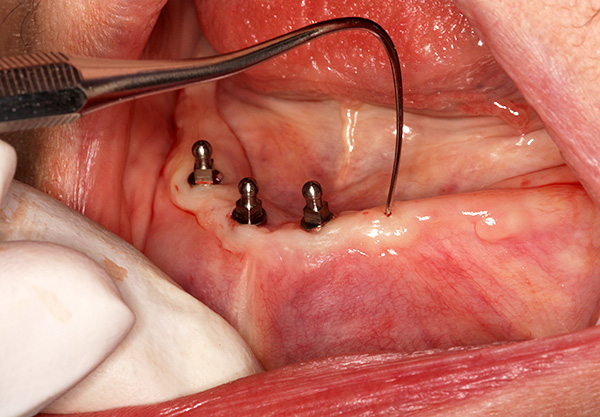
Through the prepared holes, a hole is then drilled into the bone into which the implant is screwed.In this case, the hole is made of a smaller diameter than the diameter of the thread of the implant, and the thread itself during installation not only rigidly fixes the implant, but also tightens the bone itself. Thanks to this, the mini-implant can immediately be loaded with a prosthesis.
The procedure for installing one mini-implant takes 5-10 minutes and is performed under local anesthesia. At the same time, the patient does not experience pain or any unpleasant sensations, therefore, for the most part, people respond well to the installation of such implants.
Installing a removable denture
In the ordinary case, the prosthesis is installed a few days after implantation. Impressions are taken immediately after fixation of the implants and the technique is given to the laboratory.
Sometimes, in agreement with the doctor, it is possible to make an impression before installing the implants, so that the prosthesis is ready for the procedure and the doctor installs it immediately after implantation. However, in this case, the position of the implants will have to be “customized” to fit the nests in the prosthesis and, in rare cases, inconsistencies are possible.
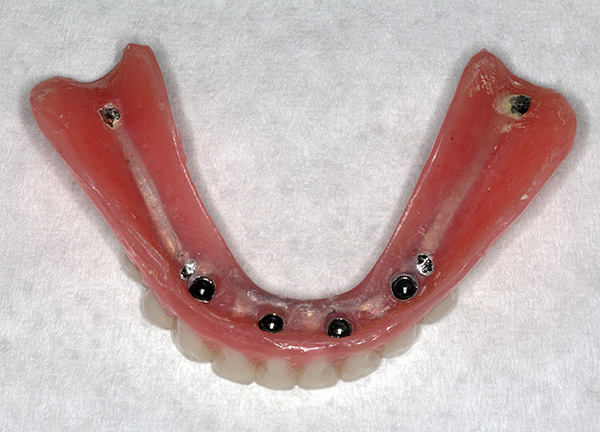
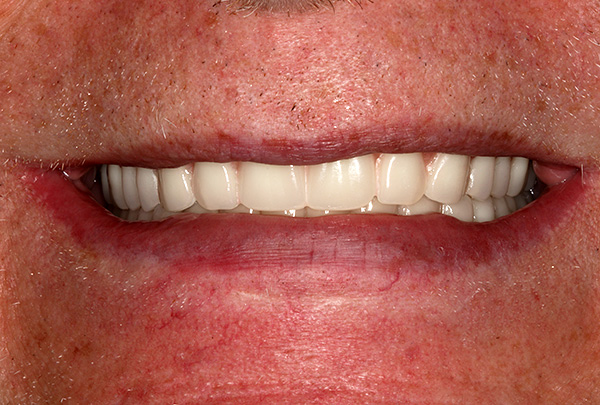
Similarly, it is possible to install an existing prosthesis on a mini-implant if the prosthesis itself is in good condition and made less than 2-3 years ago. A fixation system is built into it before the operation, and it is installed directly on the abutments. After that, the patient can remove and put on the prosthesis to perform hygiene procedures.
Fixation of the prosthesis: possible methods
Removable prostheses can be fixed on mini-implants in two ways: using silicone matrices (attachments) and without them. In the first case, the load during chewing will be somehow distributed between the implants (and hence the bone in which they are fixed) and soft tissues. In the second case, the implant will not be loaded at all, and all the pressure will be distributed only along the gum, but at the same time the prostheses themselves will be sufficiently securely fixed to avoid mobility during chewing or talking.
Immediately after implantation, the doctor can fix the prosthesis in one way, and then, after complete implant engraftment, change it.
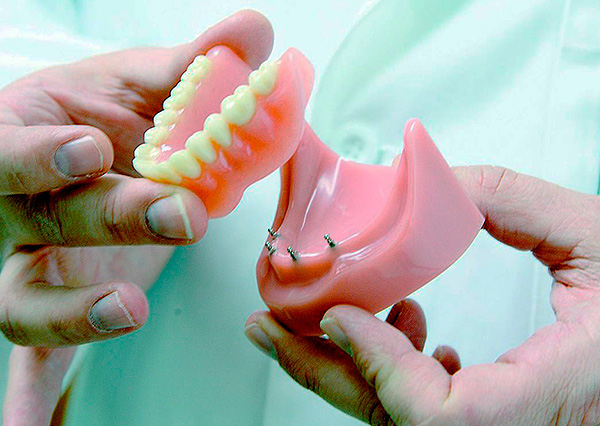
For example, on the upper jaw with a sufficiently soft bone, a prosthesis is usually installed without attachments for some time (from several weeks to several months), so that the engraftment takes place without loads and possible micro displacements of the implants. After this period, the doctor removes the prosthesis, installs silicone matrices in the recesses and puts it on, followed by loading the implant already.
On a note
Depending on the type of fixators on the prosthesis, to remove them you need to apply a force of 400 grams to 2 kg - this is enough so that the prosthesis does not lift itself when chewing viscous food, but not so much that there are difficulties when removing the patient, including and an elderly person.
Fixed prosthetics using mini implants
Fixed prostheses on mini-implants are usually installed temporarily as part of longer and larger procedures. The mini-implant cannot hold a separate crown and bear a full chewing load due to the small contact area of the root part with the bone and, accordingly, insufficiently strong fixation.
If this rule is violated and an independent crown is installed on the mini-implant, then with active chewing, the bone will gradually atrophy at the point of contact with the thread and the implant will fall out. It will be impossible to install it in the same place because of the large diameter of the hole in the bone, and it will be impossible to put an implant of a larger diameter here for the same reason that it was not installed initially instead of the mini-implant.
For the same reason, the installation of a bridge on a mini-implant is undesirable - even when the load is distributed over a 2-4 implant, it still turns out to be too large for structures of this diameter.
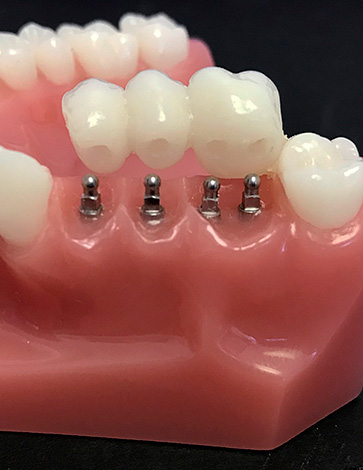
Practice shows that when several fixed mini-implants are installed on several mini-implants, the prolapse occurs on average after 1.5-3 years, maximum after 5 years.
An exception to this statistic are the Roott implants (3.5 mm diameter) and Straumann implants (3.3 mm diameter). Those models of them that are used as mini-implants are manufactured and promoted by manufacturers themselves as standard full-size implants at the lower border of the thread diameter and, in fact, are such (the normal range of diameters of mini-implants, recall - 1.8-2, 4 mm). And as standard products, they can be used for non-removable prosthetics, but always taking into account the specifics of a particular case: the location of their installation, bone characteristics, individual features of the jaw, and the number of missing teeth. When installed on such implants, fixed "bridges" normally last up to 5-6 years, and sometimes longer.
Using technology to fix an old prosthesis
For fixation on mini-implants, an old prosthesis can be used if it is not yet very worn and made with sufficient quality. It is believed that 2-3-year-old acrylic dentures with slight deterioration are quite suitable for fixing. At the same time, preparation and fixation of an old prosthesis costs much less than a new prosthesis, and takes 2-3 days in time.
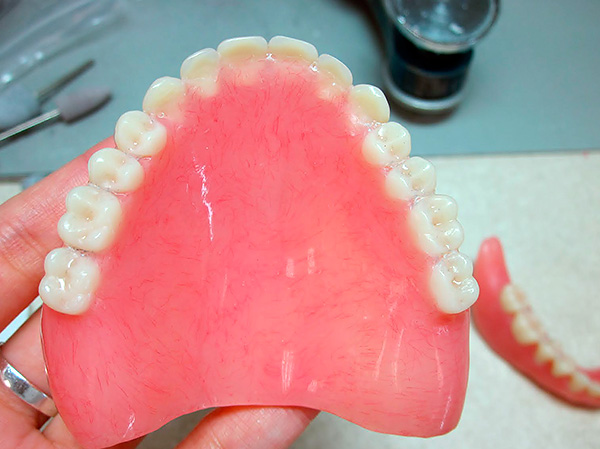
To modify the old prosthesis, deepenings for abutments of already installed implants are made in it strictly according to their projection onto a plastic base, silicone attachments are then installed in these recesses, and abutments are inserted into them, rigidly fixing the prosthesis.
This technology is good, firstly, for its low cost, and secondly, the use of a prosthesis, to which the patient is already accustomed. But she also has disadvantages. For example, a prosthesis that is initially created “for implants” usually has a less wide and not so noticeable basis. This is especially true for the upper jaw: a prosthesis fixed on implants should not block the entire sky.
Prices for the installation of mini-implants in Moscow clinics
The cost of installing mini-implants in Moscow may vary depending on the prestige of the clinic and the specific situation of a particular patient. But in general, the price range is not so great.
Below are the prices for the installation of mini-implants of different brands as of 2019:
- Osstem and Alpha BIO - an operation to install four mini-implants costs an average of 60 thousand rubles (this amount includes the cost of installing implants and the cost of the implants themselves). A new acrylic prosthesis costs another 30 thousand rubles, in total the entire system with work will cost about 90 thousand rubles. A more compact and lightweight elastic prosthesis Acry-free costs 45 thousand rubles .;
- Roott - installing one implant costs about 35 thousand rubles with the price of the implant and crown. A system of four implants with a bridge for 4 crowns will cost about 140 thousand rubles;
- Straumann - the cost of installing a similar system of four implants and four “turnkey” crowns is about 180 thousand rubles.
It is important to remember that the cost of manufacturing a prosthesis is usually 25-40% of the cost of the entire implant system. Therefore, the final price is significantly affected by the type of prosthesis and the cost of its manufacture.
Important nuances to pay attention to
As mentioned earlier, mini-implants are usually not designed for the installation of fixed prostheses (crowns, "bridges"). Sometimes basal implantation based on Roott implants is possible, which is a kind of transitional step between mini-implants and classical designs.
Normally, mini-implants should be considered as a way to fix dentures if they are displaced and fall out during conversation and chewing. Variants of their use with heavy loads are almost always undesirable or short-lived.
Further, the more mini-implants will be installed, the stronger the whole structure will be. With a small number of implants, the bone at the point of contact with the thread will quickly atrophy due to overload, and sooner or later the whole system will become loose and fall out.
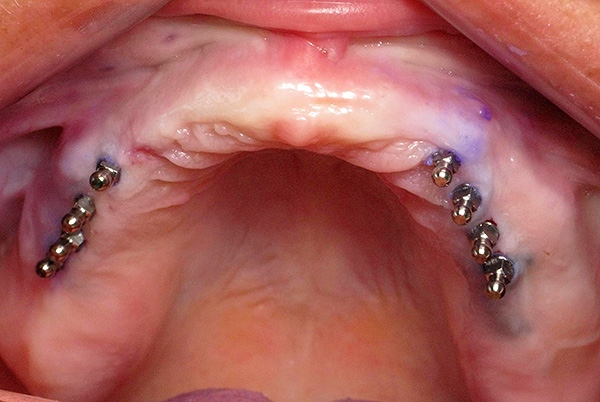
Attempts to fix the prosthesis to the minimum number of implants to save money is not the best option: you will have to change and reinstall the system relatively quickly, which will ultimately be much more expensive than initially installing the desired (recommended) number of mini implants.
The minimum recommended number of mini-implants under the prosthesis is 4 units. If the prosthesis is large and massive, then there may be more mini-implants.
If it is possible to choose, priority should be given to implants with removable abutments of the equator type, if it is impossible to install them, to implants with spherical removable abutments, and only if they cannot be delivered, then consider implants with fixed abutments.
Possible alternatives to mini implants
Mini implants themselves are an alternative to the classic full-size implants. In all cases when mini-implants are used, the design based on classical implants will be more reliable. Moreover, the minimum set of four mini-implants may well be replaced by two or three full-size analogues, and the risks of bone atrophy in the classic version will be much lower.
Therefore, if this is possible, it is preferable to install the classic implants. And only if they cannot be delivered, can the use of mini-implants be considered taking into account their specifics.
Example of placement of MDI mini implants on the lower jaw
Advantages of installing prostheses on implants

